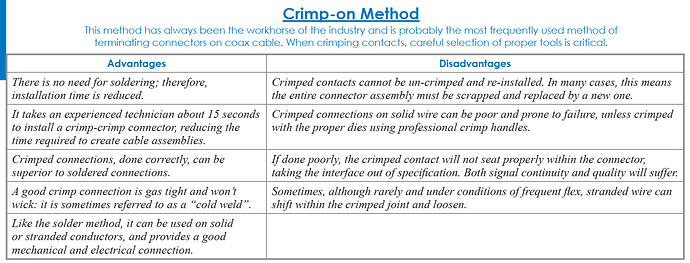The force of a proper crimp will cause the strands to weld together and form a metallic bond. Take a cross section of a good crimp and you won’t see any of the strands, or the edge of the crimp terminal for that matter
Oh, and crimped connections have less electrical resistance, although in our use case that is probably negligible.
fair enough.
why? How do you get any less resistance than a solder soaked connection? May as well be one solid wire
Turns out, crimped connections are just one solid mass of wire :D.
Solder itself has several times the resistivity of copper.
TODAY I LEARNED. I had no idea. We talking 2x-3x or like 7x-10x?
5x to 10x
Well actually even worse than that.
Tin is 6x more resistive
Lead is 13x more resistive.
Are you saying the only ones that make truly solid connections are the ~$300 name brand ones?
Not $300 name brand,
But get one that is racheting and definitely not the $5 throwaways that also come with stripping and cutting tools.
Ahh gotcha, that makes more sense.
Yeah basically get a tool dedicated for just crimping. They cost around $50.
I thought the question was about why not use PP as motor connectors instead of bullets?
Either way yea for cables connectors (battery and motors) it could be interesting as long as it as enough amps ability I guess
I’ve used power poles before (we used them in FRC) and I hate them, so chunky for no reason at all. Bullets route so much better, only thing I liked was the lock inserts
Yea but you need a few hundred $ tool to crimp it to be more reliable, than a soldered joint with a 30$ iron
nah, cheaper ones work aswell, and used ones are also an option. Was already disussed at length a few posts up.
As has already been said, in my understanding crimping is generally superior to soldering.
I wanted to add a little more background and detail as to why-
It is preferred in industry (aerospace, motorsports, marine, telecommunications, etc), but there are pros and cons of each. Crimping (with the right tool) en masse is also much quicker, repeatable, less expensive, and requires less skill in a volume manufacturing environment. It can even be automated. Some of these advantages are less relevant to home PEV builds.
NASA spec on soldering, for those interested:
NASA-STD-8739.3.pdf (452.8 KB)
NASA spec on crimping:
nasa-std-8739.4a_w_change_2.pdf (3.5 MB)
For esk8 specifically, (although I solder everything) my biggest concern would be the frailty of a soldered connection over time. Solder makes a strong, but brittle connection that can fail due to corrosion or vibration over time. The more solder & heat that is applied, the stiffer the resulting connection as the solder wicks up the wire. And the point on the wire at the end of the solder becomes a potential failure pt, between stiff solder and bendable, stranded wire. With enough vibration, the individual strands break. Heat shrink or a boot as strain relief is a big help for this. If you’re able to entirely pot that connection (i.e. both sides of a connector epoxied to an enclosure), you all but eliminate this failure point. Best practice is to immobilize all wiring inside an enclosure as best you can.
A side note - if your connection ever gets hot enough to melt the solder, your joint fails. If you incorrectly size your wire gauge and/or overload your circuit, high current can fail your soldered joint. I have not done the math to figure out how far outside the recommended specs you’d need to be for this to happen. To add to this - solder is a poor electrical conductor compared to copper wire. Different solders have different levels of conductivity; rosin-core is especially less conductive. If you have not intertwined your wire strands for a solid mechanical hold prior to soldering, you risk a hot connection via increased resistance.
A good crimp is essentially a cold weld - it is more reliable in vibration heavy applications, air tight, generates no heat during crimping, involves no toxic materials, but requires a specific (expensive) crimping tool. With the right tool and the right parts, there is a much tighter quality control of the outcome (less room for error). It is also easier to identify (and rework) a poor crimp than a poor solder.
Soldering is ideal for board level work. Crimping is more ideal for cabling.
All that said, a high quality solder is more or less equivalent to a high quality crimp in performance. And probably good enough for our use case, assuming it’s done correctly.
xt60 can handle more current with a lower resistance and doesn’t require the recommended 10awg wite
and xt30 can handle almost as much, and is smaller
mr/mt 60 exist, and you can change the direction of the motor in fw, no need to change phase wire order,
Soldering looks cooler. If I have slow motion clips of me crimping things in a YouTube video, I’ll be laughed off the platform.
Slow motion solder smoke, however, looks amazing shot at 120fps.
Moreover, if you start advocating crimps for everything, more electricians are going to be building batteries.
Is that what you all want?





